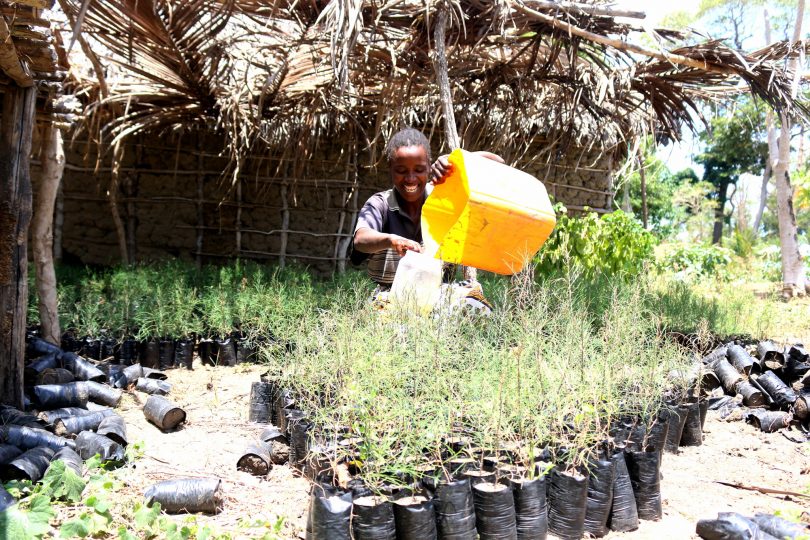This article originally appeared on the Women & Girls Hub of News Deeply, and you can find the original here. For important news about issues that affect women and girls in the developing world, you can sign up to the Women & Girls Hub email list.
By Sophie Mbugua
In many areas of rural Kenya, women spend hours each day searching for water. As they worry about the impact on their families and livelihoods, one project could help them take back the time stolen by the search for water.
LAMU COUNTY, Kenya – Every morning at 3 a.m., Esther Katuma, a 34-year-old mother of five, leaves her house in search of water. She hopes to return before her children come home from school for lunch and in time to scare away the baboons that have been devouring the bananas and pawpaws on her farm.
Every day, she says, women like her from Maisha Masha village, near Lamu County’s Witu Forest, walk over 25 kilometers (15.5 miles) through the forest, dodging wild animals, some of which are also looking for water. “Everyone, including the animals – both wild and domestic livestock – depends on water wells within the forest,” says Katuma. “The earlier you get to the well, the earlier you return home to other chores.”
With no river running through the county, Lamu residents rely on shallow wells, water pans and boreholes to harvest groundwater. Until recently, the groundwater was regularly recharged by seasonal rainfall. But a dry spell has left the area water stressed, as wells and boreholes run low and any water left becomes too salty to drink. “The wells are turning saline due to lack of recharge owing to inadequate rainfall this year,” says Dishon Mwamburi, the director of water at the Ministry of Lands and Physical Planning.
Villagers – mainly the women – are forced to dedicate more and more of their time searching for water. But a new project is helping communities adapt to the water shortage, letting women get back to their livelihoods and their children.
Maisha Masha village is a relatively new settlement, built on a wetland that was meant to provide residents with a reliable water source. Natural or manmade areas that are seasonally or permanently flooded with water, wetlands make up 3 to 4 percent of Kenya’s land surface. But according to Mwamburi, unplanned settlements and an increased number of people and livestock in search of arable land have been encroaching on the wetlands over the past few years. At the same time, climate change has been leading to hotter dry seasons and shorter rainy seasons. Together, those factors have resulted in a water shortage.

A young woman rides along the Witu Mpeketoni Road in search of water. (Sophie Mbugua)
For many women in Lamu County, the time spent looking for water is time away from their children. Damaris Kandenge worries that while she is busy on her long walks for water, her children are vulnerable to being targeted by the militia group al-Shabab, a militant Islamic group with ties to al-Qaida. “This forest is inhabited by the al-Shabab group,” she says. “I worry about my children. What if someone tries to recruit them and I never get to know about it?”
Kandenge, along with 20 women and 10 men, formed the Back to Eden group a year ago, to support their families through beekeeping and tree planting. She says other mothers in the group worry that, without supervision, their children are missing school or engaging in underage sex. Kandenge points to the fact that so far this year, the number of young girls getting pregnant is higher than in past years. “We have no time for the children,” she says. “When you return and find an empty bowl of food, you assume the children have come home for lunch.”
The long hours spent searching for water also lead to conflicts at home, says Kandenge, with some men engaging in extramarital affairs because, they say, their wives are neglecting them. “This water has become a thorn,” she says. “It’s a race between finding water, ensuring our children are safe and our men are happy – all in one woman.”
According to the 2015 Joint Monitoring Program by the World Health Organization and United Nations Children’s Fund, 2.6 billion people have gained access to improved drinking water sources since 1990. Despite the global achievements, Kandenge and Katuma are among 663 million people who are still without access to water globally.
Mwamburi says that due to financial constraints, there are no current plans to provide water solutions to Maisha Masha village. So the World Agroforestry Centre (ICRAF) has stepped in to help. As part of the Intergovernmental Authority on Development IGADBiodiversity Management Programme, funded by the European Union, ICRAF has been working with Maisha Masha residents, promoting water technologies to help them access water and cope with rainfall variability. “We are combining roof catchment, rainwater harvesting, surface runoff and groundwater to ensure they have water available throughout the year,” says Wilfred Muriithi, a groundwater and agriculture engineer at ICRAF.

A hand dug shallow well under construction at Maisha Masha village. (Sophie Mbugua)
Muriithi and his team are helping the Back to Eden group build a freshwater shallow well that should be ready for use by the end of October. The hand-dug well, which costs over $500 and is co-funded by the community and ICRAF, taps into a flowing underground aquifer and should permanently serve the community, says Muriithi.
The shallow wells make use of natural aquifer’s in the ground to extract clean water flowing from the highlands to the ocean. An aquifer is an underground layer of water bearing, permeable rock that can be tapped into, providing a constant source of clean water.
Muriithi says the wells will provide a long-lasting solution to Lamu’s water as long as they are well maintained. “[Their] sustainability depends on the water usage and protection of the aquifers upstream,” he says.
Kandenge can’t hide her excitement as she talks about the benefits the shallow well will bring to her family and community. She plans to use it to rescue the vegetables and 2,000 seedlings currently drying up in her nursery, and for beekeeping and household use. And the time she will save not having to walk miles for water, she plans to spend with her family. “I cannot wait for this well to gush out water,” she says.



